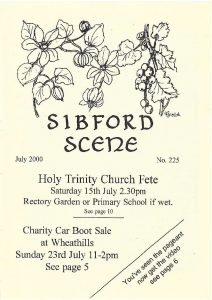Book review - "The Sibford Millennium Panels"
This book, published by Andrew and Martin Gordon in memory of their mother Peggy, a former village resident, is both an intriguing snapshot of the Sibfords for turn-of-the-millennium villagers and a potentially valuable historical record for future generations.
Mollie Picken’s heroic achievement in galvanising 66 villagers of hugely varying experience into action with dye and thread is most appropriately celebrated through the medium of Andrew’s excellent photographs. The 36 pages are divided into two sections, separated by a map showing the locations of the buildings featured.
The book’s first half shows the panels as they appear on display, allowing one to follow the historical work at the bottom in chronological order. Two pages are devoted to each panel, with a guide giving numbers for each piece of work. These relate – not quite infallibly – to the central map. There’s also a page number for houses which appear the second half. The tall format of the book, matching the format of the panels, enables the detail of each picture to be easily distinguished.
The second part shows individual pieces of work enlarged to varying degrees, with much interesting information about the buildings’ background, researched and written by Andrew. I was fascinated by the history and trust that current residents will not mind their names appearing: they will, after all, themselves be history. The ‘Directory of Artists’ at the end must be used in connection with the numbered panel guides at the front, from which you can go to the individual houses in the second half. The system takes a little getting used to.
The book, which is designed by Nigel Fletcher, is a pleasure to look at and to handle. I thought it a wonderful way to remember Sibford’s contributions to the year 2000, including the panels’ connection with the Pageant, which Andrew mentions in his helpful introduction. Sibford has not-been so celebrated in print since Leslie Baily’s From Romans to Rock ’n Roll in 1960, and, as Andrew says, it would be nice to think that someone “at home with their demesnes and their heriots” might be inspired by the work to produce a really detailed history.
J.W.
